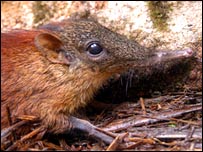bebby
Samojed


 Broj postova : 1155 Broj postova : 1155
Lokacija : Maltese Land
Registration date : 02.05.2008
 |  Naslov: Otkrivena nova vrsta sisavaca... Naslov: Otkrivena nova vrsta sisavaca...  pon ruj 01, 2008 11:52 am pon ruj 01, 2008 11:52 am | |
|  Nova vrsta sisavaca otkrivena je u planinama Tanzanije. Čudna životinja nosi stručni naziv Rhynochocyon udzungwensis, veličine je domaće mačke, izgleda kao križanac minijaturne antilope i mravojeda, ima sivu dugačku njušku i nabijeno tijelo. "Ovo je moje najveće otkriće", izjavio je Galen Rathbun, član australske Akademije. Rathbun smatra kako je životinja povezana s nekim afričkim vrstama poput slonova, morskih krava i mravojeda, a znanstvenici se nadaju kako će imati više informacija nakon provedenog istraživanja. Evo nesto sam nasla na engleskom: The bizarre-looking creature, dubbed Rhynochocyon udzungwensis, is a type of giant elephant shrew, or sengi.
The cat-sized animal, which is reported in the Journal
of Zoology, looks like a cross between a miniature antelope and a small
anteater.
It has a grey face, a long, flexible snout, a bulky, amber body, a jet-black rump and it stands on spindly legs.
"This is one of the most exciting discoveries of my
career," said Galen Rathbun, from the California Academy of Sciences,
who helped to confirm the animal was new to science along with an
international team of colleagues.
Despite its name, the creature, along with the 15 other known species of elephant shrew, is not actually related to shrews.
Dr Rathbun told the BBC News website: "Elephant shrews
are only found in Africa. They were originally described as shrews
because they superficially resembled shrews in Europe and in America."
In fact, the creature is more closely related to a group
of African mammals, which includes elephants, sea cows, aardvarks and
hyraxes, having shared a common ancestor with them about 100 million
years ago.
"This is why they are also known as sengis," explained Dr Rathbun.
The new species was first caught on film in 2005 in
Ndundulu Forest in Tanzania's Udzungwa Mountains by a camera trap set
by Francesco Rovero, from the Trento Museum of Natural Sciences in
Italy.
Dr Rathbun said: "I got these images, and said to
myself: 'Boy, these look strange'. But you can't describe something new
based just on photographs, so in March 2006, we went back in and
collected some specimens."
 Flashy creatures Flashy creatures
He told the BBC that it quickly became apparent that the creatures were new to science.
He said: "Elephant shrews are almost all distinguished
by distinctive colour patterns, and this is especially true of the
forest-dwelling giant sengis.
"They are all quite flashy - one species has a bright
golden rump, another checkers along the rump - so when you have a
colour pattern that just isn't similar to what is out there, you know
it is fairly obvious that you have got something new.
"And this one, with its grey face and black rump, was pretty different."
As well as its distinctive colouring, the new species is
also larger than other species of giant elephant shrew, weighing 700g
(25oz) and measuring about 30cm (12in) in length.
It uses its long, flexible nose and tongue to flick up insects, such as termites, and it is most active in daylight.
Dr Rathbun added: "They are behaviourally fairly simple
- they are not like a dog or cat you can interact with - but they are
so bizarre-looking and a lot of their behavioural ecology is so unique
and interesting, you kind of get wrapped up with them."
The scientists say there is still much to learn about the Rhynochocyon udzungwensis,
but they hope further research will help to answer questions about how
many of the animals exist, their range and how closely the animals live
together.
Tanzania's Udzungwa Mountains are biodiverse-rich. In
addition to this new species, a number of other new animals have been
found there, including the Udzungwa partridge, the Phillips' Congo
shrew, and a new genus of monkey known as Kipunji as well as several
reptiles and amphibians.
Dr Rathbun said it was vital the area and its inhabitants in this biodiversity "hotspot" were protected.
| |
|
rock_chic
Moderator


 Broj postova : 1099 Broj postova : 1099
Age : 30
Registration date : 15.04.2008
 | |
stryker
Moderator


 Broj postova : 1527 Broj postova : 1527
Age : 39
Lokacija : Veliko Orasje
Registration date : 16.04.2008
 |  Naslov: Re: Otkrivena nova vrsta sisavaca... Naslov: Re: Otkrivena nova vrsta sisavaca...  pon ruj 08, 2008 1:06 am pon ruj 08, 2008 1:06 am | |
| | |
|
bebby
Samojed


 Broj postova : 1155 Broj postova : 1155
Lokacija : Maltese Land
Registration date : 02.05.2008
 |  Naslov: Re: Otkrivena nova vrsta sisavaca... Naslov: Re: Otkrivena nova vrsta sisavaca...  uto ruj 09, 2008 7:25 pm uto ruj 09, 2008 7:25 pm | |
| I meni takodjer  | |
|
Sponsored content
 |  Naslov: Re: Otkrivena nova vrsta sisavaca... Naslov: Re: Otkrivena nova vrsta sisavaca...  | |
| |
|
